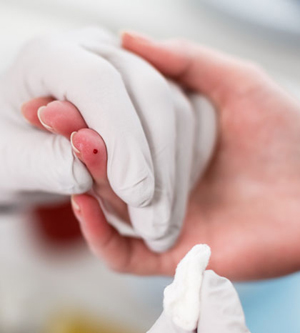Fingersticks on Mastectomy Patients
Are they appropriate? Are they safe?
by Dennis Ernst • June 25, 2021

Is it acceptable to perform fingersticks on the same side as a mastectomy? Is it acceptable to perform venipunctures on mastectomy patients if the patient gave permission? Answers to these commonly asked questions have their roots in the CLSI standards.
The rule against drawing from the same side of a prior mastectomy without physician's permission is hard and fast: such draws require physician's permission. That includes fingersticks. In the CLSI standard titled Collection of Capillary Blood Specimens (GP42, published in 2020) permission is required for the same reason as it is for venipunctures. Namely, the body's ability to fight an infection in the affected limb is compromised because of lymph node removal during mastectomy. Trauma and/or infection to the affected side can result in long-term lymphedema, which can lead to an attorney's three favorite words: pain and suffering.
Some argue that mastectomies are done with less removal of lymph nodes today than in the past, so there is less likelihood of complications from a venipuncture. That’s true. The problem is that some mastectomies are still radical. It depends on the surgeon and the extent of the metastasis. How is the person who is about to draw blood from a mastectomy patient supposed to know?
It’s not prudent for the phlebotomist to assume lymph nodes have been preserved. The standard for venipunctures published by the Clinical and Laboratory Standards Institute (CLSI), document H3, states physician’s permission must be obtained before drawing on the same side of the mastectomy. The physician is in the best position to know the extent of lymph node removal, not the phlebotomist.
Because this rule is so prevalent in the literature, if a patient develops complications and seeks compensation, the facility doesn’t have much of a legal leg to stand on. Even if the patient gives permission—verbal or in writing—it may not exonerate the facility should complications develop. If the patient provides permission, then sues for pain and suffering, her attorney can effectively argue that the patient was not aware of the risks involved, and was not in a position to give informed consent. Signed waivers may not be bullet proof.
Without a thorough knowledge of the standards, it’s difficult to know the risk. Make sure you know the standards, and operate within them and according to your procedure manual at all times.
Related Posts and Information
overall rating: my rating: log in to rate
capillary CLSI fingerstick lymph node lymphedema mastectomy YouTube
31 Comments
I read the article and there is no mention of fingersticks in this article.
Unless I'm missing it, I still don't have an answer or information from this article.
Ti Cyprian, 07/14/2021 16:36:29
I stand corrected
Thank you, Ti, for pointing this out. I apologize profusely for the gaff. I can imagine how frustrating it must have been to read my post and leave uninformed. I have since corrected the post and apologize for the omission.
Dennis Ernst, 07/14/2021 17:02:06
